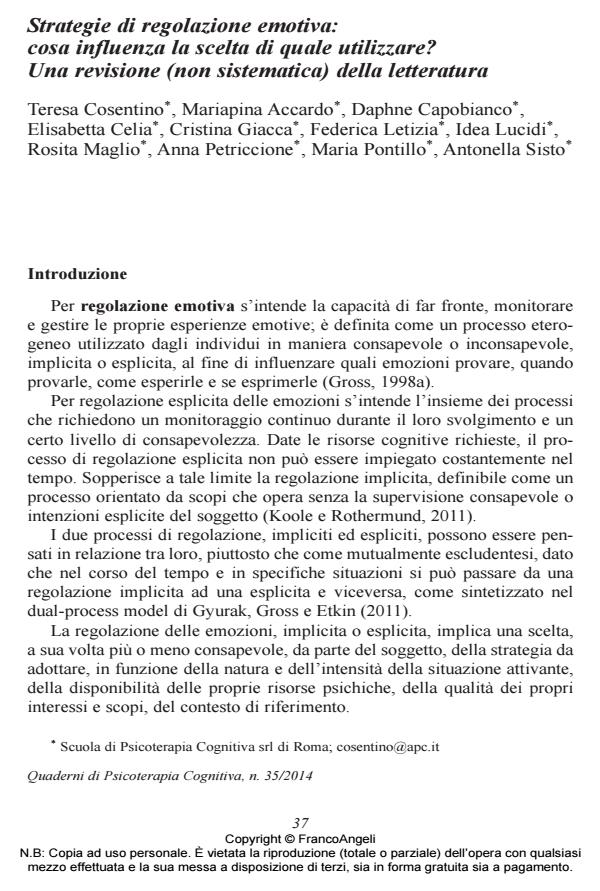Strategie di regolazione emotiva: cosa influenza la scelta di quale utilizzare? Una revisione (non sistematica) della letteratura
Titolo Rivista QUADERNI DI PSICOTERAPIA COGNITIVA
Autori/Curatori Teresa Cosentino, Mariapina Accardo, Daphne Capobianco, Elisabetta Celia, Cristina Giacca, Federica Letizia, Idea Lucidi, Rosita Maglio, Anna Petriccione, Maria Pontillo, Antonella Sisto
Anno di pubblicazione 2014 Fascicolo 2014/35
Lingua Italiano Numero pagine 19 P. 37-55 Dimensione file 76 KB
DOI 10.3280/QPC2014-035003
Il DOI è il codice a barre della proprietà intellettuale: per saperne di più
clicca qui
Qui sotto puoi vedere in anteprima la prima pagina di questo articolo.
Se questo articolo ti interessa, lo puoi acquistare (e scaricare in formato pdf) seguendo le facili indicazioni per acquistare il download credit. Acquista Download Credits per scaricare questo Articolo in formato PDF

FrancoAngeli è membro della Publishers International Linking Association, Inc (PILA)associazione indipendente e non profit per facilitare (attraverso i servizi tecnologici implementati da CrossRef.org) l’accesso degli studiosi ai contenuti digitali nelle pubblicazioni professionali e scientifiche
La regolazione emotiva (RE) è un set eterogeneo di processi che coinvolge cambiamenti nel sistema di risposte esperienziali, comportamentali e fisiologiche. Dati sperimentali dimostrano che i soggetti che utilizzano flessibilmente le diverse strategie di RE hanno un miglior adattamento a lungo termine (Mauss e Gross, 2004). La maggior parte delle persone è in grado di regolare le emozioni negative; di contro, gran parte dei disturbi mentali implicano una disregolazione emotiva. Cosa impedisce l’uso flessibile delle strategie di regolazione emotiva? Tale interrogativo ha guidato gli autori in questa revisione non sistematica della letteratura, selezionando in particolare gli studi inerenti le variabili che influenzano il ricorso alle diverse strategie. Emerge quanto questa scelta sia influenzata da fattori quali la desiderabilità sociale, l’età, il sesso, tratti di personalità, le credenze del soggetto circa la modificabilità dell’esperienza emotiva, gli scopi perseguiti. Tuttavia, i lavori consultati non consentono di rispondere esaustivamente all’interrogativo. Secondo gli autori, a determinare la scelta, più o meno consapevole, della strategia da utilizzare per la RE potrebbe essere il sistema di credenze della persona circa il "come e se" esprimere/ esperire determinate emozioni in connessione con i valori e gli scopi che si perseguono.
Parole chiave:Strategia di regolazione emotiva, emozioni, scopi, valori, regolazione delle emozioni.
Teresa Cosentino, Mariapina Accardo, Daphne Capobianco, Elisabetta Celia, Cristina Giacca, Federica Letizia, Idea Lucidi, Rosita Maglio, Anna Petriccione, Maria Pontillo, Antonella Sisto, Strategie di regolazione emotiva: cosa influenza la scelta di quale utilizzare? Una revisione (non sistematica) della letteratura in "QUADERNI DI PSICOTERAPIA COGNITIVA" 35/2014, pp 37-55, DOI: 10.3280/QPC2014-035003